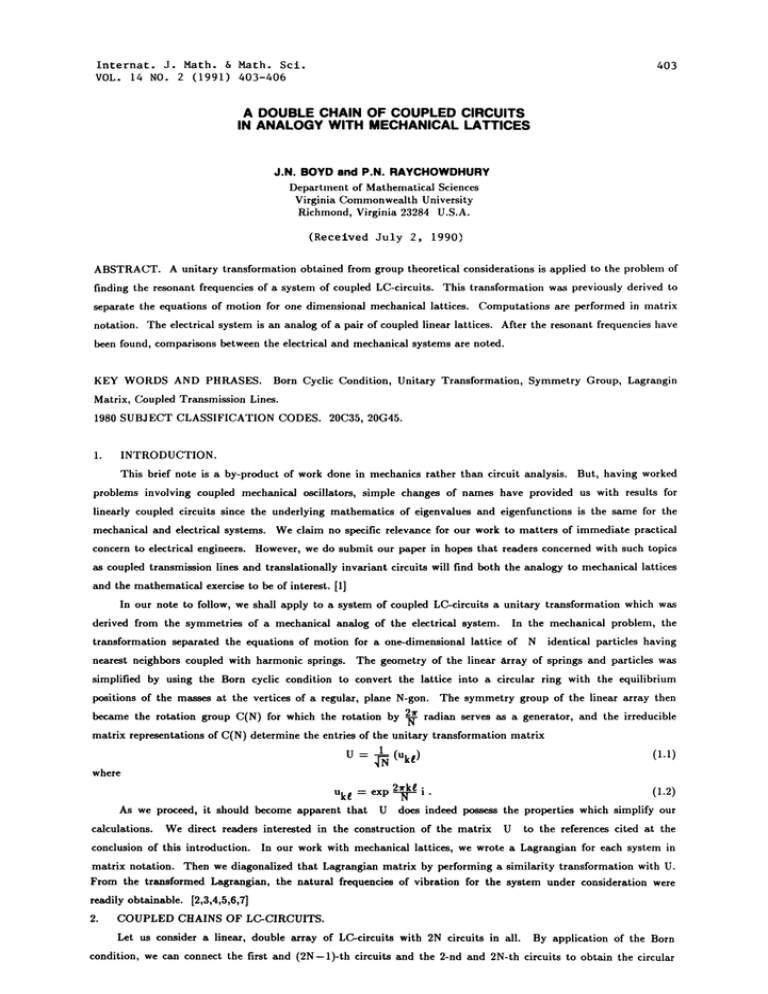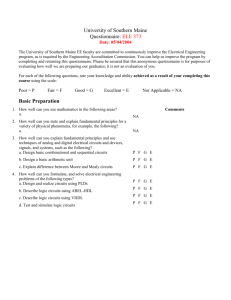A DOUBLE CHAIN OF COUPLED CIRCUITS IN ANALOGY WITH MECHANICAL LATTICES
advertisement

Internat. J. Math. & Math. Sci.
VOL. 14 NO. 2 (1991) 403-406
403
A DOUBLE CHAIN OF COUPLED CIRCUITS
IN ANALOGY WITH MECHANICAL LATTICES
J.N. BOYD and P.N. RAYCHOWDHURY
Department of Mathematical Sciences
Virginia Commonwealth University
Richmond, Virginia 23284 U.S.A.
(Received July 2, 1990)
ABSTRACT. A unitary transformation obtained from group theoretical considerations is applied to the problem of
finding the resonant frequencies of a system of coupled LC-circuits. This transformation was previously derived to
separate the equations of motion for one dimensional mechanical lattices. Computations are performed in matrix
notation. The electrical system is an analog of a pair of coupled linear lattices. After the resonant frequencies have
been found, comparisons between the electrical and mechanical systems are noted.
KEY WORDS AND PHRASES. Born Cyclic Condition, Unitary Transformation, Symmetry Group, Lagrangin
Matrix, Coupled Transmission Lines.
1980 SUBJECT CLASSIFICATION CODES. 20C35, 20G45.
INTRODUCTION.
1.
This brief note is a by-product of work done in mechanics rather than circuit analysis. But, having worked
problems involving coupled mechanical oscillators, simple changes of names have provided us with results for
linearly coupled circuits since the underlying mathematics of eigenvalues and eigenfunctions is the same for the
mechanical and electrical systems. We claim no specific relevance for our work to matters of immediate practical
concern to electrical engineers.
as
However,
we do submit our paper in
hopes that readers concerned with such topics
coupled transmission lines and translationally invariant circuits will find both the analogy to mechanical lattices
and the mathematical exercise to be of interest.
In
our note to
follow, we shall apply to
a
[1]
system of coupled LC-circuits a unitary transformation which
derived from the symmetries of a mechanical analog of the electrical system.
was
In the mechanical problem, the
transformation separated the equations of motion for a one-dimensional lattice of N
identical particles having
nearest neighbors coupled with harmonic springs. The geometry of the linear brray of springs and particles was
simplified by using the Born cyclic condition to convert the lattice into a circular ring with the equilibrium
positions of the masses at the vertices of a regular, plane N-gon. The symmetry group of the linear array then
radian serves as
C(N) for which the rotation by
matrix representations of C(N) determine the entries of the unitary transformation
became the rotation group
U
where
Uke
As
we
a
generator, and the irreducible
matrix
N (Uke)
(1.1)
exp
(1.2)
proceed, it should become apparent that U does indeed possess the properties which simplify our
We direct readers interested in the construction of the matrix U to the references cited at the
conclusion of this introduction. In our work with mechanical lattices, we wrote a Lagrangian for each system in
matrix notation. Then we diagonalized that Lagrangian matrix by performing a similarity transformation with U.
From the transformed Lagrangian, the natural frequencies of vibration for the system under consideration were
calculations.
readily obtainable.
2.
[2,3,4,5,6,7]
COUPLED CHAINS OF LC-CIRCUITS.
Let us consider a linear, double array of LC-circuits with 2N circuits in all. By application of the Born
condition, we can connect the first and (2N--1)-th circuits and the 2-nd and 2N-th circuits to obtain the circular
404
J.N. BOYD AND P.N. RAYCHOWDHURY
array with the connection as indicated in Figure I. We desire to compute the resonant frequencies of this system.
Figure 1.
Circuits 2k and 2k +
(for k
an
integer) are coupled by capacitors
Circuits k and k =t= 2 are coupled by capacitors
C
having resistances
C., having resistances R 2. All
R.
(See Figure 2.)
inductors have the same value, L,
with resistance R.
We recognize three, interwoven linear arrays of circuits, each array being analogous to a linear lattice of
particles and springs:
1, 2N;
1, 2, 3
2N
1, 3,5
2N
3,2N
2, 4, 6,
2N
2, 2N.
1; and
We also recognize that the permutation P which sends circuit k to circuit k + l(Mod 2N) is a symmetry
p2N} is a symmetry group of the double array
operation for the system and that the group G
{P, P2, p3
once we have connected the first and second circuits to the
(2N
1)-th and 2N-th circuits. Furthermore, G is
isomorphic to the rotation group C(2N).
qk
In Figure 1, there are 2N current loops indicated. In the k-th circuit, dlk denotes the current in its loop while
lkdt gives the charge associated with that current on each capacitor. Figure 2 shows the currents in all
=/
parts of the k-th circuit.
R
L
c -T" -t
+t ._[_c
h
Figure 2.
M F,
Since there is no impressed E
we can write the k-th circuit equation as
L(Ik + (R + 2R + 2R2)/Ik
[9
l(qk_
-
+qk+l
Rt(Ik-1 +
2
22(qk_2 +qk+:t)
0.
The equations for all the circuits can then be condensed into the single matrix equation
LO +
+
a AO +
+
Aq
+
0.
qN)"
In Equation 2, Q is the column matrix giving the 2N components of the charge: Q col(qtq
symmetric
are
and
B
A
The
matrices
(----col(qlq
and
Similarly,
col(dltdl dlN)
.../:N)
and have dimensions 2N x 2N:
DOUBLE CHAIN OF COUPLED CIRCITITS
0
0
-1
-1
0
0
0
2
-1
0
0
0
0
0
-1
2
2
0
-1
0
-1
0
0
2
0
-1
0
-1
-1
0
2
0
0
0
0
-1
0
0
0
2
-1
0
-1
2
0
-1
-1
2
405
i
n
We now perform
a similarity transformation upon this matrix
equation. The unitary transformation matrix
-
is obtained from Equations 1.1 and 1.2 by replacing N with 2N. Thus U becomes
4ri
2ri
exp-exp--8’i
4’i
exp-- exp6’i exp 12’i
exp---
exp
6ri
12’i
exp
2N
exp
18’i
2N
If we denote the transformed charge vector by P=UQ=col(plp
LU( + RUQ + R,UAU-UQ + RUBU-1UQ +
Li +
R + R,UAU-’ + RuUBU-I +
pN ), Equation 2 then becomes
UAU-1UQ+
UAU-1p
+
UBU-1UQ
UBU-1p
0.
0
(3)
By straightforward computation previously performed in simplifying the equations of motion for mechanical
lattices
[2],
we know that
si
0
4sin 2a"
UAU-I=
and
4sin
0
UBU-I=
0
0
0
0
0
0
0
4sin 3a"
0
0
0
0
0
0
0
--
2N
0
0
0
4sin2.3_
0
0
0
0
4sin
406
J.N. BOYD AND P.N. RAYCHOWDHURY
Then matrix Equation 3 implies that the equation for the k-th transformed coordinate is
ea(k)
The technique for solution of this differential equation by letting Pk
(R + 4R sin22 + 4R
find that, if
resonant frequencies
3.
sin
--) < 4L( sin2 +
sin
is well known. We
-), we obtain the
t(k)
OBSERVATIONS.
In the event that
R=R1---R
0, the frequency distribution for k
{1,2,3
2N} reduces to that for coupled
linear lattices for which there is no energy loss during oscillation.
The array of circuits corresponds to a double chain of identical particles as shown in Figure 3. Line segments
between vertices indicate connecting ideal springs. The unit cell for the double chain is a parallelogram, and the
triangles with vertices k, k+l, k+2 are isosceles. The frequencies computed correspond to longitudinal
vibrations which are parallel to the center line
We observe that the chains, 1,3,5
(CL) of the chain.
2N-1 and 2,4,6
,2N, are uncoupled by letting
C1
o. If the
resistances are all taken to be zero, the resulting frequency distribution is just that for longitudinal vibrations in a
linear lattice of N particles with mass numerically equal to L which are connected by harmonic springs of force
[2].
constant
Figure 3.
REFERENCES
IEEE Trans. Educ. 31 (1988), 234-6.
1.
Louw, W.J., "Transmission Lines Revisited,"
2.
Boyd, J.N. and Raychowdhury, P.N., "An Application of Projection Operators to a One Dimensional
Crystal," Bulletin of the Institute of Mathematics, Academia Sinica 7 (1979),
133-144.
their
Velocities,"
"A One Dimensional Crystal with Nearest Neighbors Coupled Through
in ASME Journal of Dynamic Systems, Measurement
and Control 103 (1981), 293-6.
"Group Representations in Lagrangian Mechanics."
114A (1982),
604-8.
"Finite Group Representation Theory Applied to Coupled LC-Circuits,"
Journal of Engineering Sciences 9 (1983), 43-9.
"Wave Prorogations in Two-Dimensional Lattices,"
Pure and Applied Mathematika Sciences XX (1984), 1-8.
"A Group Theoretic Approach to Generalized Harmonic Vibrations in a
One Dimensional Lattice," International Journal of Mathematics and Mathematical Sciences
9
(1986), 131-6.




